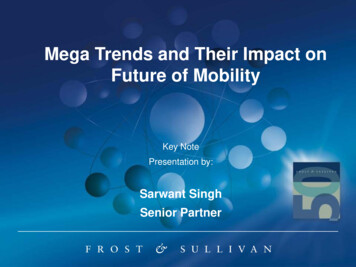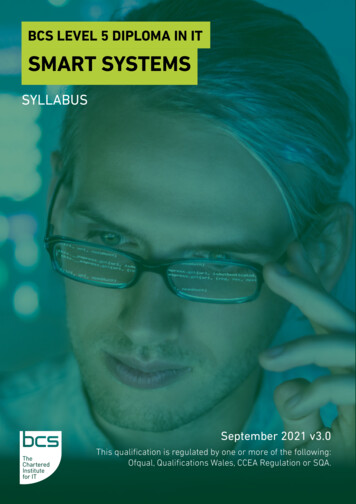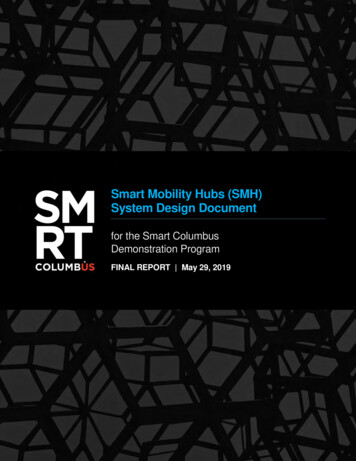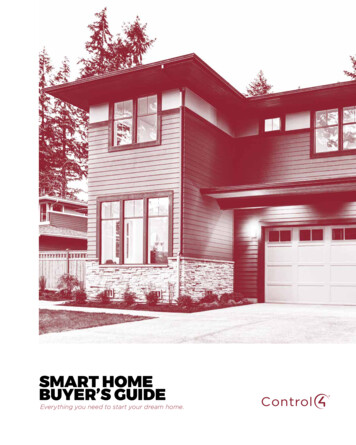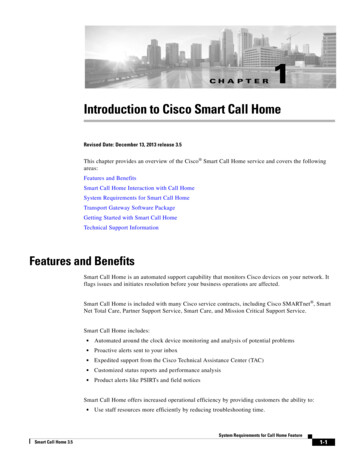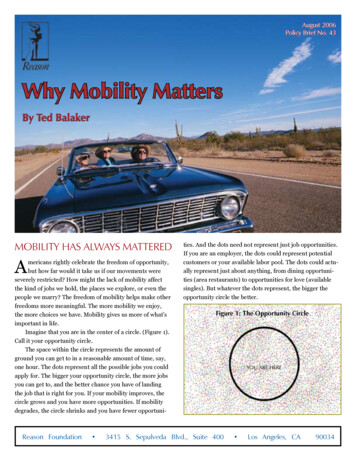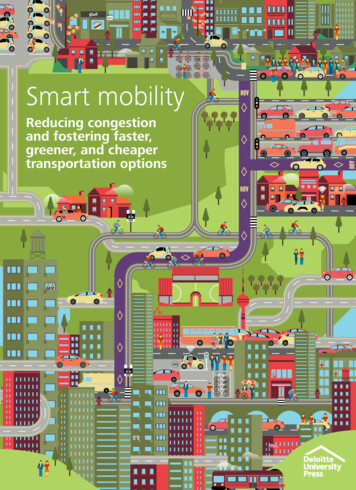
Transcription
Smart mobilityReducing congestionand fostering faster,greener, and cheapertransportation options
Smart mobilityDeloitte Consulting LLP’s transportation practice works closely withgovernment leaders to improve performance, enhance efficiency, drivetransformation, and advance constituent services. Our teams can helpstates manage congestion, improve citizen service delivery, and fosterefficient operations.
Reducing congestion and fostering faster, greener, and cheaper transportation optionsAbout the authorsPeter ViechnickiPeter Viechnicki is a strategic analysis manager and data scientist with Deloitte Services LP, wherehe focuses on developing innovative public-sector research using geospatial and natural languageprocessing techniques. Follow him on Twitter @pviechnicki.Abhijit KhuperkarAbhijit Khuperkar, of Deloitte Support Services India Pvt. Ltd., is a research manager with theDeloitte Center for Health Solutions. He is focused on data-driven research and analysis in the public sector and the life sciences and health care industry.Tiffany Dovey FishmanTiffany Dovey Fishman, a senior manager with Deloitte Research, Deloitte Services LP, is responsible for public sector research and thought leadership for Deloitte’s public sector industry practice.Her research focuses on how emerging issues in technology, business, and society will impact organizations. She has written extensively on a wide range of transportation issues, including publicprivate partnerships, congestion management, and intelligent transportation systems. Fishman canbe reached by email at tfishman@deloitte.com or on Twitter @tdoveyfishman.William D. EggersWilliam D. Eggers is a director with Deloitte Services LP, where he leads Deloitte’s public sectorresearch. He is the author of eight books, including his latest (with Paul Macmillan), The SolutionRevolution: How Business, Government, and Social Enterprises are Teaming Up to Solve Society’sToughest Problems (Harvard Business Review Press, 2013). Follow him on Twitter @wdeggers orcontact him by email at weggers@deloitte.com.
Smart mobilityAcknowledgementsThe authors would like to thank the following individuals for providing helpful input into thisresearch: Steve Keathley and Jim Templeton of Deloitte Consulting LLP; Kathryn Alsegaf andMaureen Johnson of Deloitte Touche Tohmatsu Limited; Bharath Gangula, Steve Schmith,Daniel Byler, Patricia Buckley, and Danny Bachman of Deloitte Services LP; Peggy Tadej at theNorthern Virginia Regional Council; Allen Greenberg at the US Federal Highway Administration;Lisa Rayle of the University of California, Berkeley; Todd Litman of the Victoria TransportationPolicy Institute; Kris Keith of the Central Texas Regional Mobility Authority Support Team; CarlEppich, Ben Lake, Rick Harbison, and John Duncan of the Greater Portland (Maine) Council ofGovernments; Lori Kaplan and Andrew McGee of the Central Indiana Regional TransportationAuthority; Bruce Wright of the Fairfax Alliance for Better Biking; and Elizabeth DeJesus of theNorth Florida Transportation Planning Organization; and Robert Poole of the Reason Foundation.The authors would also like to thank Kenny Ling, Amit Shivpuja, Clare Stankwitz, ZachWhitman, Zac Andereck, and Matthew Gentile for their assistance with the geospatial components of this project. The authors would like to extend special thanks to Pankaj Kishnani forhis extensive research support, and also thank Vikrant Jain, Mohinder Sutrave, Pulkit Kapoor,Amrita Datar, Mahesh Kelkar, and Nikita Shah of Deloitte Services LP—India for their contributions to this research. Finally, we gratefully acknowledge the congestion data provided by the TexasTransportation Institute in their 2012 Urban Mobility Report, which was central to our calculations.ContactsSteve KeathleyNational Public Sector Transportation leaderPrincipalDeloitte Consulting LLP 1 512 226 4481skeathley@deloitte.comAllen HockenburyLead Client Service Partner for Deloitte’s Federal Energy and Transportation accountsDirectorDeloitte Services LP 1 571 814 7450ahockenbury@deloitte.com
Reducing congestion and fostering faster, greener, and cheaper transportation optionsContentsThe promise of smart mobility 2Nurturing the elements of smart mobility ecosystemsRidesharing 46Modernizing how empty passenger seats in vehicles are filledBike commuting 13Unleashing its economic, health, and safety benefitsCarsharing 20Extending the benefits of automobility without the attendant costsOn-demand ride services 27Disrupting and complementing taxi serviceExpanding mobility ecosystems by reconsidering transportationinvestments 30Appendix A 31Four modes of alternative mobility definedAppendix B 32Methodologies used in estimating economic benefits of alternativemobility modesEndnotes 381
Smart mobilityThe promise of smart mobilityNEW business models inspired by the sharing economy and disruptive technologiesare ushering in an exciting new age in transportation: the era of smart mobility. The arrivalof on-demand ride services like Uber and Lyft,real-time ridesharing services such as Carmaand Zimride, carsharing programs such asZipcar and car2go, bike sharing programs, andthousands of miles of new urban bike lanes areall changing how people get around.Commuters no longer need to own a car tohave one at their disposal. They don’t have topre-arrange carpools to share a ride with others headed in the same direction. They needn’twait for a ride home when it’s pouring downrain and there’s not an empty cab in sight.For their part, automakers increasingly seethemselves as both product manufacturersand mobility services companies. In additionto developing next-generation connected andautonomous vehicles that will improve trafficflows and safety, automakers are investing in awide swath of new mobility services—everything from carsharing and rental services tomultimodal trip-planning apps.There’s no question that consumers havebeen the primary beneficiaries of new mobilityservices. The question facing urban plannersis how today’s expanded mobility ecosystemcan help advance public policy goals such asencouraging higher productivity and reducing congestion, while bringing related benefitssuch as fewer traffic accidents, better air quality, and a smaller urban footprint for parking.Can alternative transportation modes helpmetropolitan areas reduce traffic congestionwithout spending tens of billions of dollars onnew roads, tunnels, and light rail? And if so,2what are the most promising strategies? Whichapproaches work best in which cities? How canautomakers and transportation officials worktogether to address changing mobility needs?These are just a few of the questions ouranalysis attempts to answer.This study takes a data-driven look at whatmetropolitan areas can gain from expandedmobility ecosystems. We compare alternativeapproaches from ridesharing to biking, andexplore how governments can focus scarceinvestment dollars on areas where they can dothe most good.Traffic congestion in America:Grim and getting worseThe need for answers to America’s trafficgridlock problem becomes more acute eachyear. In much of the nation, traffic congestionhas increased to alarming levels, with associated costs estimated at 121 billion, equivalentto slightly more than 1 percent of all annual USpersonal consumption.1The average American spends about 34hours every year sitting in traffic. That’s awhopping 5.5 billion hours for all commuters.2The economic opportunity cost is staggering: 330 million daily, or about 124 billion everyyear. If nothing changes, this cost could growto 186 billion by 2030.3And that’s just the cost to individuals.Every mile we drive costs governments 7.5cents, and at almost 3 trillion vehicle-milestraveled per year, those miles add up.4 If youinclude the cost of congestion, air pollution,or even lost property value near roadways, the
Reducing congestion and fostering faster, greener, and cheaper transportation optionstotal estimated external cost of driving runsbetween 27 cents and 55 cents per mile.5For decades, governments have tried invain to develop solutions to address congestion. High-occupancy vehicle (HOV) lanesand costly public transportation networksmay have slowed the growth of congestion,but commute times continue to lengthen inAmerica’s urban centers. Estimates suggestthat only 15 percent in congestion savings canbe achieved even with widespread deployment of such conventional measures to allmajor freeways.6Clearly, a new approach is needed.3
Smart mobilityNurturing the elements ofsmart mobility ecosystemsHELSINKI, Finland has announced anaudacious goal: By 2025, the city plans tomake it unnecessary for any city resident toown a private car. The goal is an on-demandmobility system that would allow customersto choose among public and private transportproviders and assemble the fastest or cheapest way of getting anywhere they need to go atany time.“The city’s role is to enable that market toemerge,” explains Sonja Heikkilä, a transportation engineer with the city.7Bus routes would be dynamic, changingbased on current demand at any moment.From planning to payment, every elementof the system would be accessible throughmobile devices.8Citizens could arrange a personalized travelexperience irrespective of location. Whereverthey are in the city, they could access a varietyof options with their phone: a rideshare, an ondemand bus, an automated car, special transport for children, or traditional public transit.Residents could purchase “mobility packages”from private operators that would give them ahost of options depending on weather, time ofday, and demand.Today, our congested transportation systemis designed around infrastructure and vehicles:roads, bridges, subways, and buses. Helsinki’s2025 vision points to a very different futuremodel, one designed around individual mobility—moving each traveler from point A topoint B as quickly and efficiently as possible.US cities also are beginning to reimagine theirtransportation ecosystems around this concept.4A transportation system designed aroundindividual mobility would prominently featurefour modes of alternative mobility (as well asmore traditional modes such as buses): Ridesharing (i.e., carpooling), whichtaps into an abundant yet underutilizedresource: empty car seats. This optiondoesn’t add any new vehicles to the system, and that’s why it could help reducethe traffic congestion that plagues mostcities today. Unfortunately, carpoolinghas declined from around 20 percent ofall commuters in 1970 to less than 10percent today.9 Bicycle commuting, which has been onthe upswing in recent years, particularly inEurope and in cities with relatively flat terrain, miles of bike lanes, and other cyclinginfrastructure. For commutes of a few milesor less, biking is often the fastest way to getto work.10 Carsharing, enabled by new technologythat allows companies and individuals torent cars by the minute or hour. On-demand ride services companies suchas Uber and Lyft, which allow ordinarymotorists to use their personal cars tooffer prearranged transportation services.These services, enabled by mobile and GPStechnologies, are making the taxi marketmore competitive.See appendix A for a more detailed definition and description of each mode.
Reducing congestion and fostering faster, greener, and cheaper transportation optionsFigure 1. Growth rates for alternative transit modes1000.00Log of growth index (2007 base)These forms of transportation have seendifferent levels of popularity in recent years.Ridesharing, as mentioned above, has been indecline for decades. On-demand ride services,on the other hand, have seen rapid growthsince their launch several years ago.Individual, corporate, and governmentincentives line up well for some of thesemodes, and poorly for others. Where theincentives align, we see faster growth (figure1). Ridesharing, for example, suffers from alack of both individual incentives to participateand private sector incentives for technologicalinnovation. Carsharing’s growth has been morerapid due in part to automobile manufacturers’entry into the carsharing business and relatively enthusiastic support from municipalities.We now take a more detailed look atthe current and future role that each of thefour transport modes can play in addressingAmerica’s traffic congestion problems.100.0010.001.000.102007 2008 2009 2010 2011 2012 2013 2014CarpoolBikingCarshareOn-demandNote: On-demand growth figures use 2012 base year as indexand are approximated from slate.com and futureadvisor.com.Sources: American Community Survey and University of California,Berkeley Transportation Sustainability Research Center, Slate.com,and FutureAdvisor.com.Graphic: Deloitte University Press DUPress.comOUR METHODOLOGYTo understand which cities—and even neighborhoods—stand to gain the most from better congestion reductionstrategies, we examined a variety of data, most prominently commuter behavior at the census-tract level. Usingdata from the Census Bureau’s American Community Survey (ACS) and Census Transportation Planning Products(CTPP), we estimated the number of people who could reasonably rideshare or bike to work.11 We then tallied uphow many vehicle miles traveled (VMT) and congestion-cost dollars would be saved if all of these commuters usedalternative transportation.12For carsharing, we used a slightly different approach. Using ACS data, we estimated the population in eachtract matching the target demographics of carsharers.13 With these numbers, we estimated the number ofneighborhoods nationwide with strong carsharing potential.14On-demand ride services, the newest of the alternative transportation modes we studied, also offers the leastavailable data.15 Our estimates for this mode are thus less detailed.For each mode, we compare current usage rates with estimates representing our model’s maximum possible usage.A more detailed description of our methodology for capturing the existing and potential reach of alternativemobility approaches can be found in appendix B.5
Smart mobilityRidesharingModernizing how empty passengerseats in vehicles are filledBowling alone and drivingalone: The long, slow declineof carpooling in AmericaFOR decades after World War II, the carpool to work was a daily ritual for millionsof Americans, mostly suburban (and then,mostly male). Through the 1960s and into themid-1970s, one in five workers carpooled totheir jobs.16How times have changed.Most suburban—and even many urban—households now have at least two cars. Moreoften than not, both parents drive into work bythemselves, in separate cars. Today, fewer thanone in ten commuters nationwide shares a rideto work.17 Fully 77 percent of Americans driveto work alone.And, in contrast to the suburban businesscommuters of days past, carpooling today isoften associated with lower-income workerswith limited resources.18 Many of today’s carpoolers do so out of economic necessity ratherthan choice.6But the news on the ridesharing front isn’tall bad. Despite the 30-year decline in carpooling rates, several factors—new technologiesenabling real-time ride matching, changingattitudes toward car ownership, the growth ofthe sharing economy, and an increasing number of managed lanes that provide incentivesfor carpooling—offer significant opportunitiesto revive ridesharing.We analyzed ridesharing rates in 171 metroareas across the United States and identifiedsome important factors that will help determine ridesharing’s future.Measuring ridesharing’seconomic potentialThe beauty of ridesharing lies in the factthat it taps into an abundant yet underutilized resource: the empty seats in cars. Everyday millions of Americans drive to work bythemselves, in parallel with neighbors whovery often are driving to similar locations.These empty seats in cars represent a huge
Reducing congestion and fostering faster, greener, and cheaper transportation optionssource of waste in our transportation system—but potentially also a huge opportunityfor improvement.What is the potential impact from reducingthis waste? To model potential rideshare savings in cities, we treat transportation choicesas a function of fuel costs, congestion patterns,attitudes, and assembly costs. (See appendixB for a detailed description of our methodology.)19 We imagine a world in which assembly costs for ridesharing approach zero andsocietal attitudes toward ridesharing are moresupportive. This scenario allows us to calculatethe personal and societal benefits that couldaccrue if all commuters who could reasonablyrideshare to work did so.A detailed examination of our methodology can be found inappendix B, but here isthe Cliff ’s notes version.We used geospatialanalysis of demographicdata to calculate thenumber of likely ridematch pairs within eachcensus tract who livewithin one mile of oneanother, leave for workat the same time in themorning, and travel tothe same workplace tract. To account for commuters who engage in “trip chaining”—stopping along the way to and from work to carryout other business—we reduced this numberby 16 percent.20 We then calculated the reduction in vehicle miles traveled (VMT) and fuelsavings if the pair chooses to rideshare.Figure 2 shows ridesharing’s economicpotential, nationwide and for the 10 largest cities by projected number of new carpoolers.We estimate that almost 19 million commuters in US metro areas could switch fromdriving to ridesharing if current barriers toridesharing were eliminated, resulting in a27 percent overall modal share.21 This switchwould have enormous societal benefits: Weproject maximum potential savings fromincreased ridesharing at 30.3 billion annually. These savings would accrue from severalsources: 15.8 billion in direct annual savings to new carpoolers due to reduced vehicleupkeep, 11.6 billion in indirect savings fromlowered congestion costs, and 1.8 billionin reduced annual road infrastructure costs.Furthermore, traffic-related accidents couldfall by 22,915 annually (yielding 847 million annual savings), while carbon dioxideemissions would fall by 9.1 million metrictons annually—yielding societal savings of 338 million.To be clear, our estimates represent a bestcase scenario that may take years to be fullyWe estimate that almost 19 millioncommuters in US metro areas could switchfrom driving to ridesharing if currentbarriers to ridesharing were eliminated,resulting in a 27 percentoverall modal share.realized. Our point is to show the vast, andcurrently mostly unrealized, potential of thismode of transportation. Our results furtherreveal some general trends indicating whereridesharing could be most effective.An important finding of our study is that“ring” neighborhoods could become ridesharing hotspots. Neighborhoods with high ridesharing potential, according to our analysis,are usually distributed in a ring 10 to 15 milesoutside each city’s urban core. These neighborhoods tend to have higher concentrationsof commuters traveling each day to similarworkplace destinations, both in the city centerand in office parks and edge cities throughoutthe metro area. (Here’s a surprising fact about7
Smart mobilityFigure 2. Estimated benefits of expanded ridesharing, US and 10 largest metro areasRidesharersMetro area (MSA)PotentialnewCurrentProjectedtotalProjected annualvehicle miles reducedNew York-Newark-Jersey City NY-NJ-PA Metro Area638,290908,8841,547,1741,438,712,191Los Angeles-Long Beach-Anaheim CA Metro perville-Elgin IL-IN-WI Metro t Worth-Arlington TX Metro Area320,503612,063932,5661,128,969,564Miami-Fort Lauderdale-West Palm Beach FL he Woodlands-Sugar Land TX Metro -Camden-Wilmington PA-NJ-DE-MDMetro ington-Alexandria DC-VA-MD-WVMetro Area317,102428,901746,003738,895,120Atlanta-Sandy Springs-Roswell GA Metro ge-Newton MA-NH Metro 39,54529,813,18428,240,874,445National totalNote: New ridesharers, economic potential, and projected savings are all calculated assuming a future state where barriers to ridesharingare near zero. See appendix B for details of calculations in this table.Source: Deloitte research, based on Census Bureau American Community Survey statistics 2014.tomorrow’s ridesharing: It’s not only commutesfrom the suburbs to the city center which offerthe best opportunities for increasing ridesharing. Many commuters who live in tracts thatcan be hotspots for ridesharing do not in factwork in a city center.22)A classic example is Indianapolis, whereneighborhoods with the highest numbers ofpotential new ridesharers are concentratedabout 10 to 12 miles from the city center, insuburbs such as Carmel, Fishers, Greenwood,and Brownsburg (figure 3). The map in figure3 shows census tracts with higher projectedlevels of ridesharers as darker blue. The bullseye pattern of carpool potential shows clearlyhere because there are relatively few physicalboundaries near the city and no contiguousmetro areas to complicate the pattern.8Eight ways to encourageridesharingOur analysis demonstrates the enormouseconomic potential of ridesharing— 30.3billion in annual savings if ridesharing wereembraced by its maximum potential user base,or about a fifth of US commuters. So how dowe get there? Experience teaches that it won’tbe easy. The following strategies, however,could help make progress.1. Expand tax incentives to rideshare.Extending the employee pre-tax benefitscurrently available for parking, transitpasses, and vanpool costs to ridesharing could increase its appeal to commuters. New technology that verifies vehicle
Reducing congestion and fostering faster, greener, and cheaper transportation optionsMobility savings tocommuters ( nnual fuelsavingsMobility savings to cities ( cost savingsover 25-yearperiodAnnual roadconstructioncost savingsAnnualsavings fromaccidentsavoidedAnnual carbonemissionsavingsTotal annualmobilitysavings ( pancy could aid the implementation ofthis benefit. Carma’s new ridesharing app,for example, was tested in Austin, Texasin 2014, and program evaluation resultsare due in the spring of 2015. Carma’s appverifies the presence of two passengers in anautomobile, which qualifies the automobilefor an automatically applied 50 percent tolldiscount; with three or more passengers,the auto is eligible for a 100 percent rebate.23The total cost of this pilot was slightly lessthan 1 million, partially funded througha federal grant. The program is continuing to grow. A mid-year interim reportshowed 322 new carpools encouraged bythe program and approximately 250 dailycarpool trips in the fourth quarter of 2014.24The estimated cost of constructing newlanes to provide the same capacity would bebetween 5.8 million and 17.4 million.252. Improve ridematching platforms’ customer experience. Most cities we studiedhave already invested in online ridematching platforms (all but 6 of 79 cities26) or participate in a statewide rideshare platform.But none of these platforms has attractedenough members to achieve a critical massof commuter participation. Cities needto determine how best to marshal privatesector innovation to bring first-class userinterfaces, highly reliable service, incentivesfor participation, and widespread publicawareness to ridematching.9
Smart mobilityFigure 3. Rideshare potential in the Indianapolis area (darker blue areas have greater ianapolisGreenwoodBloomingtonProjected new 1728–79138–203300–396533–703 917Sources: American Community Survey 2012 1-year estimates andDeloitte Services LP ridesharing projections.If policymakers and on-demand car serviceproviders began to view each other as alliesin the battle to reduce congestion, then thepublic sector might make quicker progressin achieving its goals. For example, states orcities could incentivize commercial platform providers with large user bases such10Theoretical zone ofhighest ridesharingpotential, 12 milesfrom city centerGraphic: Deloitte University Press DUPress.comas Sidecar, Uber, and Lyft to increase thepercentage of their customers who sharerides with other passengers. Such incentives might encourage providers to enhancetheir shared ride user interfaces, outreach,and marketing.
Reducing congestion and fostering faster, greener, and cheaper transportation optionsCreating incentives for increasing carpooling might also encourage on-demandservice providers to partner with carpoolproviders to create synergies, as recentlyannounced by Uber and Carpooling.com inEurope. This new deal has Uber providingfirst-mile drop-offs and last-mile pickupsto support Carpooling.com’s long-distancecarpools. 27Technological innovations are alreadypoised to improve the customer experiencefor tomorrow’s ridesharers. Mobile appsthat today measure driving habits to helpconvey insurance discounts will likely beused tomorrow to credit drivers and passengers with toll discounts in real time, withoutmaking them register as a carpooler.3. Use infrastructure investments to support ridesharing. Commuters who carpoolare motivated principally by the time ormoney they can save by doing so.28 And, asthe Federal Highway Administration hasobserved, “Infrastructure plays an important role in helping dynamic ridesharesaccumulate time and money savings” byallowing carpoolers free or reduced-costaccess to restricted lanes.29Real-time ridesharing initiatives shouldbe bundled with high-occupancy vehicle(HOV) and high-occupancy toll (HOT)lane projects, as well as in any new designated commuter lots that can facilitate theconvenient pickup and drop-off of passengers via dedicated entrance and exit ramps.For example, when a city or state securesfunding to create managed lanes, we recommend they direct a portion of those fundsinto investments in digital infrastructure forreal-time ridesharing.According to the Texas TransportationInstitute, an average 7 percent of congestionreduction can be attributed to operationaltreatments such as HOV lanes, with higherpercentages in large cities such as New Yorkand Los Angeles.30 In our study, we foundthat carpooling rates are higher by almost 1percent in metro areas with HOV lanes—asmall but significant difference.314. Focus on building critical ridesharingmass in key corridors. Rather than tryingto expand ridesharing across a wide region,planners should focus on building a criticalmass of users in particular corridors.32 Tounderstand which corridors offer the greatest ridesharing potential, planners shouldtarget the areas with the biggest potentialsupplies of carpoolers based on commutingbehavior, neighborhood demographics, andsupporting infrastructure.A base level of “guaranteed” service (meaning that a commuter will always be guaranteed a carpool on a corridor) is needed togenerate repeat users until a critical mass isachieved.33 Many cities already have guaranteed ride-home programs (56 out of 79 inour sample). These programs typically offervouchers to members to pay for a cab if theymiss their vanpool. Such programs shouldbe tied to real-time ridesharing initiatives tohelp provide a guaranteed service level untilthe corridor network is dense enough toachieve stable critical mass.5. Recruit participants through trustedchannels. The greater the number ofemployees in a given location, the morelikely it is that rideshare matches can befound. Large companies, universities, andhospitals have hundreds or thousands ofpeople working in the same setting, andthey may have a strong incentive to encourage carpooling to reduce the need forparking infrastructure. Recruiting effortsare most effective when they involve trustedchannels such as employers.3411
Smart mobilityNew employee orientations, for instance,represent an effective channel for improvingawareness of ridesharing as a commutingoption.35 Cities such as Indianapolis, IN andJacksonville, FL are exploring strategies touse employer outreach to increase ridesharing.36 Transportation demand management(TDM) agencies—usually housed in acity’s metropolitan planning organization(MPO)—can serve as a bridge betweenemployers and ridesharing providers.6. Target younger commuters. Recentyears have seen significant shifts in attitudes toward vehicle sharing, especiallyamong Millennials. Forty-two percent ofGeneration Y consumers in the UnitedStates (versus 28 percent for other generations) say they are willing to carpool ifcarpooling is readily available and convenient.37 These shifts are reflected in recentcensus data: The median age of those whocommute to work using shared rides (carpool or vanpool) in 2013 was 39, comparedwith 42.8 for single-occupancy vehicledrivers.38 Similarly, cities with youngerpopulations have slightly higher ratesof ridesharing.397. Establish public-private partnerships(PPPs) to improve mobility. PPPs are oftenused to finance large-scale capital projects. Forward-looking jurisdictions couldexpand their use of PPPs by adopting payfor-success models that specify particularmobility outcomes (for example, by settinga goal of a certain year-over-year
Zipcar and car2go, bike sharing programs, and thousands of miles of new urban bike lanes are all changing how people get around. Commuters no longer need to own a car to have one at their disposal. They don't have to pre-arrange carpools to share a ride with oth-ers headed in the same direction. They needn't
